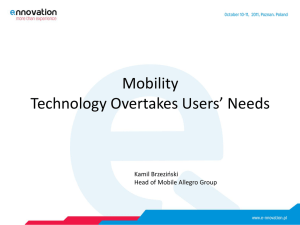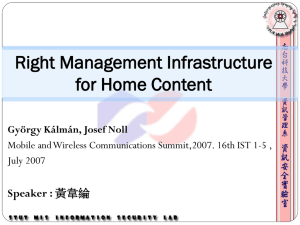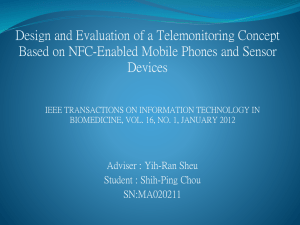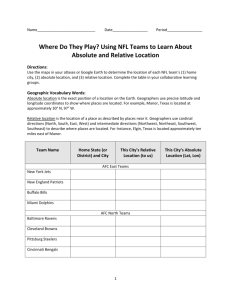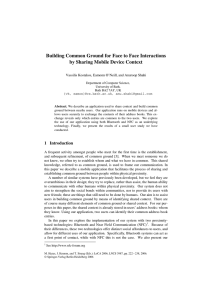Near Field Communication and Bluetooth Bridge System
advertisement
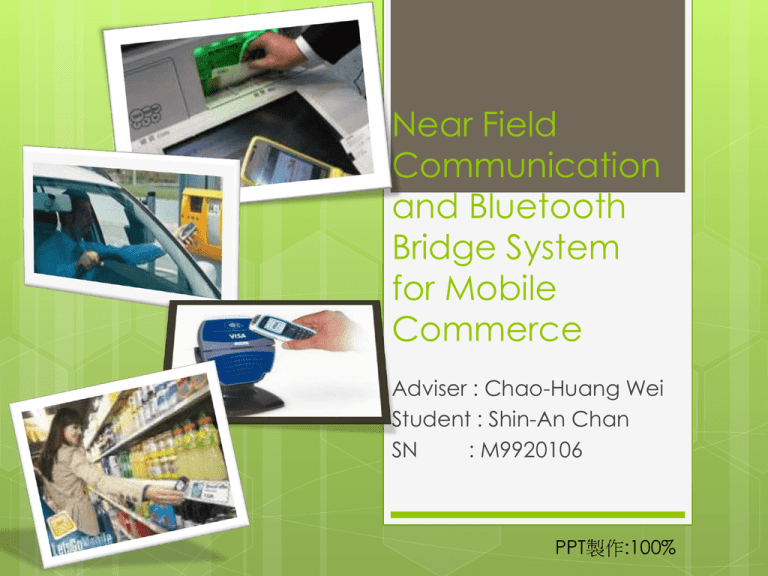
Near Field Communication and Bluetooth Bridge System for Mobile Commerce Adviser : Chao-Huang Wei Student : Shin-An Chan SN : M9920106 PPT製作:100% Outline 一. INTRODUCTION 二. NFC-BLUETOOTH BRIDGE SYSTEM Bluetooth Connection 三. MOBILE COMMERCE APPLICATION Peer-To-Peer System Application Software (Mobile Client) 四. CONCLUSIONS 五. References INTRODUCTION Near Field Communication (NFC) is an emerging wireless technology that is designed to facilitate secure ,shortrange communication between electronic. In France, Philips, in collaboration with France Telecom, Orange, Samsung, and retailer Group LaSer and Vinci Park, carried out a trial in which participating residents used the Samsung D500 mobile phones with the embedded Philips NFC chip as a means of secured payment in selected retail stores, parking facilities, and to download information about famous tourist sites, movie trailers and bus schedules. INTRODUCTION However, success of the NFC technology is also dependent on the economics of scale and mass adoption. Currently, there are not many NFC phones available in the market and it is also not reasonable to expect the majority of the consumer market to switch over from their non-NFC devices in a short timeframe. NFC-BLUETOOTH BRIDGE SYSTEM It comprises a Bluetooth enabled device, the proposed NFC-Bluetooth Bridge and an NFC card which is embedded on a smart poster. NFC-BLUETOOTH BRIDGE SYSTEM In Fig. 2, the various components, in the ordering of the labels, are (1) the Initium Promi SD 102 Bluetooth adapter, (2) an antenna for the NFC PN531, (3) the NFC PN531 board, (4) the power supply distributor PCB, and (5) a short custom-made DCE-DCE serial cable NFC-BLUETOOTH BRIDGE SYSTEM The final Bluetooth-NFC Bridge product is expected to be an embedded device of the size of today’s smallest MP3 player. The biggest portion of the body of the device will likely be the battery compartment and the NFC antenna. An alternative build (size of half a card) that draws power from its host (such as a mobile phone) that can be attached within the cover of the mobile phone is planned. However, the feasibility is not confirmed at the point of writing this paper. Bluetooth Connection The design of the software uses the Serial Port Profile (SPP) over Bluetooth. The Bluetooth link between the Promi SD102 and the mobile phone encapsulates the serial information between the mobile phone and the NFC PN531 as shown in Fig. 4. III. MOBILE COMMERCE APPLICATION In the Merchant Card System (MCS), the merchant requires only an RFID card as a representation for payment of a certain product or service he is selling. The RFID card provides a specially designed URL, unique to the product or service, to the consumer’s mobile phone when they are tapped onto each other. With the URL, the mobile phone is connected to the Goods and Payment Portal (GPP) on the Internet. Peer-To-Peer System The Peer-to-Peer System (P2PS) provides electronic transfer of cash between two owners of NFC-enabled mobile phones based on the similar principle of the MCS. The mobile phones exchange a common URL and connect to the GPP for fund transfer. This system targets private transaction such as an E-Bay meet-up transaction, and small time merchants who do not wish to be burdened with the cost of owning equipment for the other non-cash payment methods. Application Software (Mobile Client) The software is built as a MIDlet, a small program for Mobile Information Device Profile (MIDP) compliant devices, with Java 2 Platform Micro Edition (J2ME). This factor is extremely crucial in simplifying the system for mass consumers. The interface tool increases the range of user interface options available and greatly improves usability. IV. CONCLUSIONS With NFC technologies and the NFC-Bluetooth bridge that offer consumers an alternative to purchasing new NFC-enabled mobile phones, consumers are more encouraged to adopt mobile payment. The NFC-Bluetooth bridge system proposed in this paper opens an access to NFC-enabled services for a wider market of consumers with non-NFC devices. The merchant card system makes extensive use of the NFC capabilities of future mobile phones and tremendously lowers the merchants’ costs of transactions. The low cost is expected to entice merchants to adopt the system and serves as a good initiation for the technology adoption. References Near Field Communication and Bluetooth Bridge System for Mobile Commerce ,Leong, C.Y. ; Ong, K.C. ; Tan, K.K. ; Gan, O.P. ,Industrial Informatics, 2006 IEEE International Conference on ,16-18 Aug. 2006 References [1] ECMA, “Near Field Communication Whitepaper”, ECMA International, 2004 [2] Philips, “Philips and Visa Usability Study about NFC”, 2006. [3] Sun Microsystems, “Java APIs for Bluetooth JSR 82 Specifications”,2002. [4] “UM0301-06 PN531 User Manual”, Philips Semiconductors. [5] “Mifare Standard Card IC MF1 IC S50 Functional Specification”,Philips Semiconductors.
